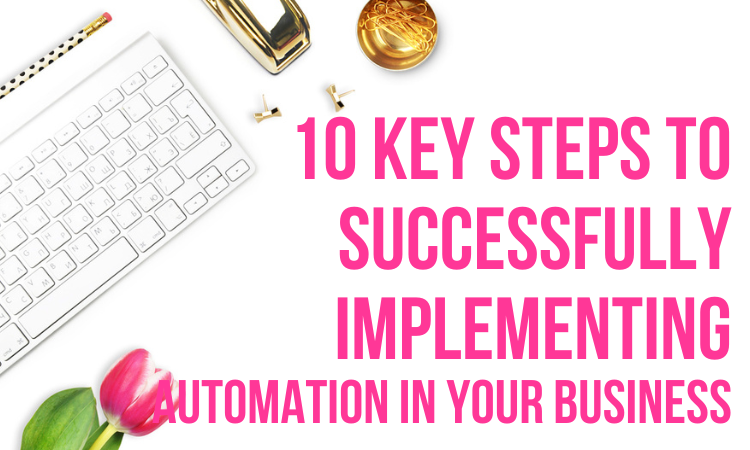Staying ahead in today’s fast-paced and highly competitive business landscape requires innovation and finding ways to optimise operations – this usually means automating processes; but successful implementation requires careful planning and execution.
In this article, we outline ten steps you need to follow to implement automation so as to increase productivity successfully, lower costs and achieve success!
This is a contributed post. Please refer to my disclosure for more information.

1. Evaluate Your Needs and Goals for Business Success
Before diving head first into automation, it’s vital that your business understands its unique requirements and goals. Take an in-depth look at your processes to identify any pain points or areas where automation could have the most significant positive effect. Conducting an extensive assessment can give valuable insight into where automation could make a difference for you – helping tailor an automation strategy around meeting business goals effectively.
2. Establish Clear Objectives
To maximise automation’s potential, setting clear objectives is crucial to its success. What outcomes are you striving for? Whether that means streamlining workflows, reducing errors, improving customer satisfaction or speeding time-to-market, setting clear goals allows you to measure progress and evaluate whether automation efforts have met their objective successfully.
3. Analyse Automation Solutions
With so many automation solutions on the market, it’s crucial that businesses conduct thorough research in order to select an automation solution that best matches their requirements and needs. Explore different vendors, read reviews, consider factors like scalability, integration capabilities, ease of use and long-term support before engaging other businesses within your industry.
You specifically need to consider what automation solutions will help the pain points in your business; for example, if you find that managing contracts is a time-consuming and error-prone process, you can resolve this by researching and choosing a contract management system to automate this
4. Craft an Implementation Plan
Once you’ve selected an automation solution, the next step should be creating an in-depth implementation plan. This plan should serve as your road map by outlining timelines, allocating resources and assigning responsibilities. Break the implementation into phases to facilitate smoother transition. Establish milestones along the way so as to monitor progress while also anticipating potential roadblocks along your automation journey.
5. Engage Stakeholders
Successful automation implementation begins by engaging key stakeholders within your organisation. Communicate the benefits of automation while also addressing any concerns or resistance that might surface from employees, managers, and executives from different departments – this transparency encouraging buy-in from all levels within an organisation and making transition more smooth overall.
6. Test and Pilot
Before undertaking large-scale automation implementation, testing and pilot runs should be conducted first to help identify any challenges or issues that might arise, refine processes accordingly, and ensure your chosen automation solution fulfils business requirements. Pilot runs also help build employee trust while showing them its advantages.
7. Train Employees
Automation can only meet its full potential if its users possess all of the skills needed to use its features efficiently. In order to be fully effective, automation systems require training of employees on how to utilise its components effectively. Make sure employees understand how to operate, interpret results and use automation technology in their everyday work processes with an extensive training program on automation solutions.
Consider offering various training methods, such as workshops, online tutorials and hands-on practice sessions, to meet different learning styles. Consider working closely with automation vendors for customised training solutions as well. By investing in employee education you empower them to embrace this new technology and contribute toward its success.
8. Monitor and Evaluate Performance
Once automation has been deployed, it’s critical to assess its ongoing performance regularly. Select key performance metrics aligning with your objectives such as productivity gains, error reduction rates, cost savings or customer satisfaction ratings; regularly assess data to pinpoint areas for optimisation while making adjustments accordingly to streamline automation processes further.
9. Optimise Automation Processes
At an ever-evolving business landscape, cultivating a culture of continuous improvement is paramount to staying relevant in today’s ever-evolving business climate. Gather feedback from employees and use data insights to optimise automation processes.
Encourage employees to contribute their experiences, suggestions and ideas for increasing automation effectiveness through this collaborative approach; this encourages employee involvement with its development within your organisation while at the same time staying aware of emerging technologies or industry trends that provide potential avenues of further automation or integration opportunities.
10. Celebrate Success and Expand Upon It
As your automation efforts take fruition, it is critical to recognise milestones and successes along the way. Acknowledging employees who embraced automation with gusto should be appreciated; success stories or lessons learned may serve to inspire other employees within your organisation.
Also consider scaling up automation across more departments or processes so it benefits more of your organisation as a whole; build upon initial implementation experience gained to accelerate further transformational and growth efforts.
Conclusion
Implementing automation into your business takes careful planning, an in-depth knowledge of goals, the right tools and strategies, and confidence when undertaking this journey. By adhering to these ten steps for automation implementation you will navigate it successfully and place yourself on a path toward increased efficiencies, productivity, cost savings and overall success in no time!



